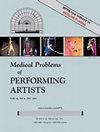Oral Cavity Movements of the Tongue During Large Interval Slurs in High-Level Horn Players: A Descriptive Study.
IF 0.7
4区 医学
Q3 MEDICINE, GENERAL & INTERNAL
引用次数: 1
Abstract
OBJECTIVE Recent publications describing lingual movement strategies within the oral cavity of brass players have established the existence of efficient and predictable movement patterns in healthy performers for a variety of performance tasks. In this study we extend the research to include the playing of large interval slurs in horn players. METHODS Real-time MRI films at 40-msec resolution were simultaneously obtained in the sagittal and coronal planes in 9 professional horn players as they performed 2 repetitions each of 3 slur sequences spanning 1 octave, 1 octave + 3rd, and 1 octave + 5th at a mezzo forte dynamic level. Nine profile lines were overlaid on the images allowing the measurement of dorsal tongue edge movement using a customized MATLAB toolkit. Movement along lines representing the anterior, middle, and posterior oral cavity in the sagittal plane, as well as the vertical height of an air channel observed in the coronal plane, are reported. RESULTS Both sagittal and coronal views demonstrate patterned tongue movements that narrow and widen the air channel during ascending and descending slurs, respectively. The magnitude of these movements is greater during larger intervals, though not perfectly consistent within each slur sequence. Additionally, the tongue position during notes tends to drift in the direction of the subsequent note in each sequence. We suggest that the observed movements may help to modulate air speed through the lips, possible attenuating embouchure muscle tension changes by assisting changes in lip vibration frequency.高水平圆号演奏者大音程发音时舌头的口腔运动:一项描述性研究。
目的最近的出版物描述了铜管乐手口腔内的语言运动策略,已经确定了健康表演者在各种表演任务中存在有效和可预测的运动模式。在本研究中,我们将研究扩展到包括大音程的圆号演奏者的演奏。方法对9名专业圆号演奏者在中强音动态水平上分别进行1八度、1八度+ 3、1八度+ 5三个音阶序列的重复演奏,在矢状面和冠状面同时获得分辨率为40毫秒的实时MRI影像。9条轮廓线叠加在图像上,使用定制的MATLAB工具包测量舌背边缘的运动。据报道,在矢状面沿代表前、中、后口腔的线条运动,以及在冠状面观察到的空气通道的垂直高度。结果矢状面和冠状面都显示了在升音和降音过程中舌头运动的模式,分别使空气通道变窄和变宽。这些运动的幅度在更大的间隔中更大,尽管在每个浆液序列中并不完全一致。此外,舌头的位置在每个音符序列中都倾向于向后面的音符方向漂移。我们认为观察到的运动可能有助于调节通过嘴唇的空气速度,可能通过帮助嘴唇振动频率的变化来减弱口部肌肉张力的变化。
本文章由计算机程序翻译,如有差异,请以英文原文为准。
求助全文
约1分钟内获得全文
求助全文
来源期刊
CiteScore
1.60
自引率
22.20%
发文量
28
审稿时长
>12 weeks
期刊介绍:
Medical Problems of Performing Artists is the first clinical medical journal devoted to the etiology, diagnosis, and treatment of medical and psychological disorders related to the performing arts. Original peer-reviewed research papers cover topics including neurologic disorders, musculoskeletal conditions, voice and hearing disorders, anxieties, stress, substance abuse, and other health issues related to actors, dancers, singers, musicians, and other performers.

 求助内容:
求助内容: 应助结果提醒方式:
应助结果提醒方式:


